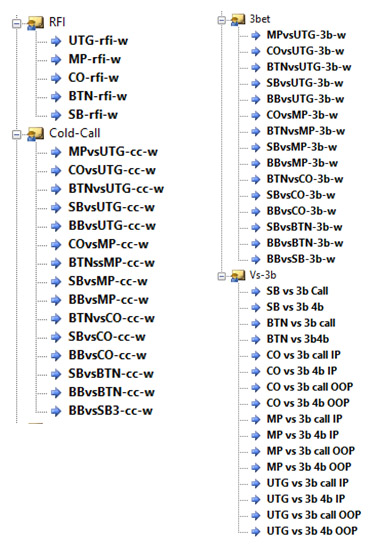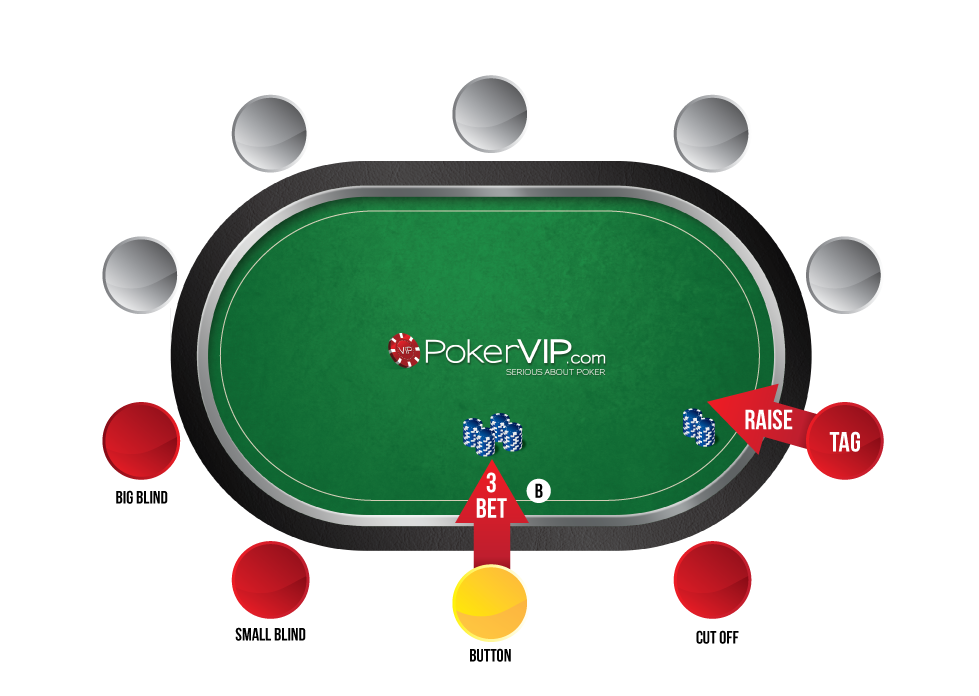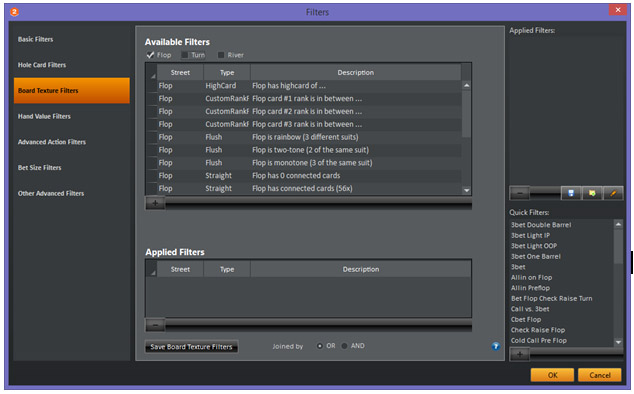Term bucket is not commonly used in poker terminology, but it is essentially just a fancy name for "grouping",. Term "buckets" is more frequently used by university researchers looking to solve poker.
The term

“buckets” is not commonly used amongst poker players. However the terminology is used much more frequently by university researchers looking to solve poker using advanced computer technology.
But what exactly is a “
flop bucket” and how can we go about using these to improve our
poker ability? Before we answer, let's discuss a certain problem we face as poker players.
The Problem
If we had a perfect strategy it would be one that could take into account any possible situation we face at the poker table. Whatever the preflop action, our holdings, or the board texture, we'd have already seen the situation before and know exactly what the best play is.
But how practical is it to develop such a strategy? Firstly take a look at a list of possible preflop situations. This list is far from exhaustive.

If the above is confusing it's essentially a brief list of many of the possible preflop situations we will face. Open raising (rfi), colding-calling (cc), 3betting (3b), defending-vs-3bets (vs 3bet). It's extremely incomplete however.
For example we have not yet specified the possible situations where we get a caller when we open raise. Surely our flop
poker strategy would be different after we open from UTG depending on whether we get an MP caller or a SB caller. We have also completely excluded
squeeze spots, facing squeezes, iso-raising, limping-behind, small-blind completes. The list goes on.
However, let's imagine for a minute this list is exhaustive even though it's far from it. We can use it to make some conservative estimates. There are roughly 50 situations documented here.
Naturally we are not going to play exactly the same way postflop in each of these situations regardless of the flop
texture. Different flop textures are going to result in different strategies depending on what our preflop range is.
Ok, so how many different flops are possible? Assuming we don't know our hole-cards there are 22,100 different possible flops. However it's also worthy of note that some of these flop textures will be identical in all except the suits. For example is there really a difference between A52 monotone of hearts, and A52 monotone of clubs? They are essentially the same board texture unless we have some strange preference for playing hands of a certain suit, which we shouldn't.
So realistically we don't need to worry about 22,100 different flop textures. If we make another conservative estimate there are least 5,000 different flop textures. There are more than this in reality but let's make a conservative estimate here, a best-case scenario.
Even if we just did the flop analysis with our 250,000 scenarios it would take us 4.75 years of non stop analysis to cover every situation
So, we have 50 different preflop situations and 5,000 different board textures. If we need to do a range analysis in each of these situations, this will be 5,000 * 50 situations for a
total of 250,000 situations.
Range analysis is not super straight forward or anything. Plus, keep in mind that we are just talking about the flop here, a detailed plan would also factor in our play on any of the 47 remaining turn cards and 46 remaining river cards. This would involve roughly
540 million different permutations not including the different lines that may occur on turn and river based on opponents line.
So hopefully you can see that we have a problem here? Even if we just did the flop analysis with our 250,000 scenarios how long would it take us? Let's imagine we were highly efficient and it only took us 10 mins per flop range. (At first it takes much longer than this for most players, to decide what we will do with our entire range). It would take us 4.75 years of non stop analysis to cover every situation. We know that off table analysis is great, but seriously, is this realistic? How can we solve this problem?
Poker AI
We can learn

a lot by thinking about how artificial intelligence is designed to play poker. The most detailed bot would probably entail using a brute force method where we sat there and entered manually those 540+ million permutations. But this is not a realistic approach, we'd be dead before our poker bot was finished.
So how exactly do we see poker bots at the tables? They must be taking some kind of short-cut somewhere, right? Exactly, they make use of “buckets”. Let's see how we can apply this concept to our own analysis.
Buckets
“Bucket” is essentially just a fancy word for “grouping”. If we were using our brute force method of analysis to try and solve the game of poker we'd be doing analysis for all of the following boards.
- K72 rainbow
- K82 rainbow
- K83 rainbow
These are clearly different boards, but how different? Does it really make sense to use a different range analysis for each board? Not given the brevity of human life. We can group all of these hands into one grouping or “bucket”.
The truth is that if we run detailed analysis on a K72 rainbow board, we will intuitively understand how to play on a K73 rainbow board. Using such a system we can dramatically reduce the number of different flops we have to run calculation for. Naturally the exact number of flop buckets will be dependent on how stringent our criteria is for distinguishing between different flops. As a rough guide we can get by with 30 flop buckets or less.
We can also bucket in other areas of our game. For example, we
iso-raise on the BTN vs a fish who limps from the CO. Do we need to run additional detailed analysis for situations where the limper is in MP or UTG? Probably not, by analysing the first situation we'd likely intuitively know how to play in the second two situations.
Here are some example flop buckets.
High Connected (Monotone, Two Tone, Rainbow)
2 High Cards (Monotone, Two Tone, Rainbow)
1 High Card, 2 Middle Connected (Monotone, Two Tone, Rainbow)
1 High, 2 Low Connected (Monotone, Two Tone, Rainbow)
Mid Connected (Monotone, Two Tone, Rainbow)
2 Mid, 1 Low (Monotone, Two Tone, Rainbow)
1 Mid, 2 Low Connected (Monotone, Two Tone, Rainbow)
Mid low Connected (Monotone, Two Tone, Rainbow)
Low Connected (Monotone, Two Tone, Rainbow)
Paired Flops (Monotone, Two Tone, Rainbow)
There are 10 categories of hand here overall. Assuming for each category we have monotone, two-tone, and rainbow, that would result in about 30 different flop buckets. It's likely possible to distinguish less between monotone textures and more between other types of textures.
For example I don't personally think there is a huge difference between a J92 and a K72 monotone texture. However I do think there is a noticeable difference with our play on an A72 rainbow board compared to a K72 rainbow board.
There is no correct answer to which flop buckets we should use. It depends on a few factors, such as the competence necessary to beat a certain game and the time we have for analysis. If we are short on time, even running analysis for a few different types of flop textures will help to increase our efficiency on other textures. The method of thinking is ultimately more important than memorising the exact ranges we should defend on certain textures.
This is essentially why humans will still have a huge edge over AI for a long time to come in the more complex variants of poker. Humans have the ability to intelligently construct ranges on the spot. A machine can't think outside what it's been programmed to do, and is only as effective as the level of detail it's programmed for. A very simplistic bot might use less than 10 flop buckets, but would usually put up very weak resistance as a result. Maybe this is still enough to beat some weak recreational players.
Range Analysis
Possibly one of the best tools for helping us to our range analysis with the various flop textures is
Flopzilla. It allows us to see how frequently our range hits certain board textures. This will expedite the process of assigning hands to certain categories such as call, fold, or raise.
Realism
The human brain simply does not have the power to process all situations off-table. Our goal when working on our game should not be to cover everything. This is basically impossible without the assistance of extremely advanced computers. NLHE 6max is still not solved to date and not even close currently.
Our goal should be to outline our strategy as efficiently as possible. In other words, it's not recommended to spend 6 months analysing K72, K73, K82 type textures. This would not be outlining our overall strategy but would instead be focusing all of our efforts on a very narrow corner of it.
Possibly one of the best tools for helping us to our range analysis with the various flop textures is
Flopzilla.
It allows us to see how frequently our range hits certain board textures.It would be better in a days analysis to pick 3 noticeably different flop textures. Perhaps a high board, a mid board, and a low board. This is still far from analysing our 30 different flop buckets, yet it does outline our overall strategy a little better. We will have a much stronger idea of how to play on a board texture we have not seen before because one of our analysis examples will be closer to this. If we spent all of our time analysing K72r and a low board textures comes up, we are not intuitively going to understand how to respond in that situation.
HM2
For those of you that use HM2, it's worth noting that the software essentially has some flop bucket filters built in.

Many players have never made use of this feature of HM2, but hopefully the relevance is clear after reading this article. We can specify for pretty much any flop texture we want. We can say what the high card is, whether the board is connected, monotone, or rainbow etc etc
Understanding board texture is actually a weakness in many player's game. If we can make it one our strengths we should enjoy a huge edge over our competition.
 “buckets” is not commonly used amongst poker players. However the terminology is used much more frequently by university researchers looking to solve poker using advanced computer technology.
“buckets” is not commonly used amongst poker players. However the terminology is used much more frequently by university researchers looking to solve poker using advanced computer technology.
 a lot by thinking about how artificial intelligence is designed to play poker. The most detailed bot would probably entail using a brute force method where we sat there and entered manually those 540+ million permutations. But this is not a realistic approach, we'd be dead before our poker bot was finished.
a lot by thinking about how artificial intelligence is designed to play poker. The most detailed bot would probably entail using a brute force method where we sat there and entered manually those 540+ million permutations. But this is not a realistic approach, we'd be dead before our poker bot was finished.


